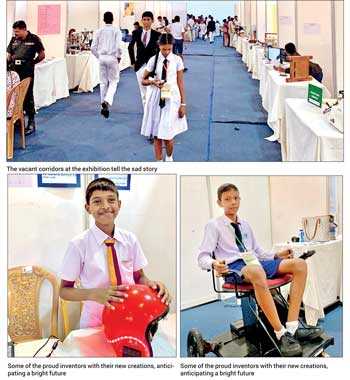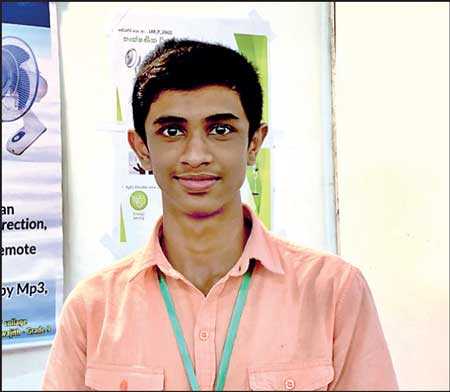Thursday Nov 20, 2025
Thursday Nov 20, 2025
Wednesday, 23 October 2019 02:18 - - {{hitsCtrl.values.hits}}
“There is only one thing stronger than all other armies of the world: and that is an idea whose time has come” – Victor Hugo
A country’s economic success and prosperity largely depends on the technological advancement it embraces and the level of creativity and innovation its population demonstrates in bringing forth inventions and improvements to current practices, products and future requirements. Historical examples of great nations who have thrived on such qualities are abundant if you look at either side of Sri Lanka to the west or to the east from Germany to Japan. These nations have continuously demonstrated their knack for innovation and creativity through the regular introduction of new products and technology for both consumption as well as for industries. They have also woven an ecosystem around the very same quality enabling them to ingrain innovation and creativity to their national DNA. This has resulted in such countries achieving and establishing a world class education system, impressive efficiency of its workforce and an increased quality of its products, that the whole world now wants to emulate.
Embracing technology
Whilst current local standards are no means to compare, we could still draw comparable accomplishments from our proud history dating back to thousands of years, which is dotted with engineering and technological marvels spanning the length and breadth of construction, town planning, tank building, irrigation and craftsmanship in art and sculpture. In its day and time, they were no less important than those unfolded in other parts of the world relating to skill and competencies required by the inhabitants, not only to plan and conceptualise but also to execute such complex monumental endeavours.
The early invaders and the colonial rulers ensured that as a nation we had permanently lost those legacies and capabilities forever. What is puzzling, however, is our current lack of interest and our indulgence in a self-destructive behaviour today, relating to scientific exploration, creativity, innovation and our general attitude towards embracing technology.
This lacklustre attitude was aptly demonstrated at the recently concluded International Exhibition for Inventions and Innovations held at the Sri Lanka Exhibition and Convention Centre in Colombo. When thrill-seekers of both urban and village origin flock to experience the cheap entertainment provided by a mega music show in their thousands, towns and villages all over Sri Lanka afford to sit in front of the ‘idiot box’ for hours to identify the winner of yet another reality show and even the blatantly corrupt politicians of all kinds are still able to draw crowds to the tune of tens of thousands to their public rallies, this annual event which was of real significance to showcase the hidden talent drew crowds merely in their hundreds.
A nation at peril
The above is a clear and present danger showing the signs of a nation at peril.
But who is looking or taking notice is the next pertinent question that begs to be answered. It is not the politicians who provide daily rhetoric regarding how they can transform the country through only their unique plan. It is also not the bureaucrats who more often are seen holding placards on the road and working to rule to ensure their pound of flesh is secured instead of being at their desk to serve the country. At the end it is the general public who have become numb and blind thanks to all the atrocities that have been committed against them who might be interested to spare a few minutes to understand this predicament. Our only hope lies in reawakening the ordinary citizen, the kith and kin of you and me to come forward and challenge our present way of thinking and initiate a transformation that may at least spare our future generations in the years to come. But how and who will bring forth the level of urgency and the expediency with which we should embark on this mission critical task needs to be looked at in more detail.
Passion and energy of the exhibitors
The exhibition which was held over three days was packed with inventors of all kind; young and old, urban and rural, amateur and experienced, male and female and the exhibits simple and complex. The sparkling eyes that lit up when detailing how the product worked, the body language that demonstrated enormous levels of self-confidence and the tone of the voice that took the visitor by surprise due to its passion and energy albeit the modest ordinary demeanour of the inventor all yearned for only one thing, the need for recognition and collaboration.
They have undertaken long journeys as far as from Jaffna, Polonnaruwa, Trincomalee and Weeraketiya, etc. to be at the capital for the event, have found their own means to stay in Colombo during the period of the exhibition and weathered modest infrastructure and facilities at the venue to showcase their creativity and special competencies to fellow Sri Lankans. But who had seen them and how many had appreciated them? And most importantly amongst those who visited, who could provide them with the resources and a platform to either improve upon what is already invented or to commercialise and take their new concepts to the next level?
How the Japanese do it
Japan provides a fabulous example as to how through the state direction and guidance such entrepreneurial and innovative skills of those inventors were harnessed to transform its economy’s international competitiveness. Having enacted the ‘Science and Technology Basic Law’ in 1995, the Japanese government outlined an integrated state policy towards science and technology. Five-year science and technology basic plans were then rolled out successively by the Japanese government, clearly defining priority fields and important goals, in its quest to strengthen Japan’s scientific and technological capacity and advancing the country’s industrial competitiveness.
On 22 January 2016, Japan’s cabinet endorsed the ‘5th Science and Technology Basic Plan’ to cover the five-year period from 2016 to 2021, demonstrating the consistency in policy and direction immaterial of the government in power.
An action plan to revamp the exhibition
At the exhibition, the usual advertising fanfare associated in a Colombo event was definitely lacking and there were no hoardings or banners of any mobile operator, energy drink, milk powder nor soap brands at the venue. There were no media promoting the event nor did you find those so called big corporate conglomerates with a ‘conscientious mind’ to lend a hand to this event in order to create the noise and visibility it richly deserved. In this context the organisers of the event ‘Sri Lanka Inventors Commission’ and all those who contributed to make it happen should be congratulated for organising and holding the event for yet another year amidst great difficulties.
In order to ensure that the great pain they endured in doing so annually is well worth the effort, the writer is of the opinion that a broad framework should be drafted as follows to ensure wider public participation and an active private sector involvement to bridge the gap between the exhibitor’s ideas to realisation.
Developed countries and the recently graduated industrialised nations have unique state agencies that promote and provide backbone infrastructure to foster creativity and innovation. Institutes such as Ministry of International Trade and Industry (MITI), New Energy and Industrial Technology Development Organisation (NEDO) of Japan, ‘Enterprise Singapore’ in Singapore, National Innovation Agency (NIA) in Thailand, National Innovation Foundation (NIF) in India and National High Technology Programme in China are just a few examples from the region. Sri Lanka too does not lack in numbers of such institutions, whose mandate resonates well with similar objectives and therefore forming a broader alliance in organising this event is possible.
The NSF, IIT, Ministry of Science and Technology, Ministry of Health, Ministry of industries, Ministry of Education, Ministry of Higher Education, Ministry of Vocational Training and Skill Development are but a few who could genuinely get involved initially. The strength and expertise of these partners would help to promote and position the event as a significant national exhibition in our annual calendar.
It is imperative that in a world cluttered with advertising and media blitz, both print and digital, finding or securing a space that attracts the attention of the general public is daunting.
This is exactly why the organisers through the strength of the common platform already created as above should approach either the state television or private television channels to engage them for a well-structured media campaign to create the much needed awareness of the event and more importantly the national significance of such an event to our own economic growth trajectory. Print, digital and FM media partners too can complement the above by conducting their own programs such as interviews, success stories of local inventors, articles regarding global outlook for inventors apart from advertising the event.
As Sri Lankans, we are all well aware that great ideas, concepts, business plans and inventions do accumulate dust more often than not inside cupboards that line along the many corridors of our universities, ministries and other state agencies. This in itself explains the magnitude of the problem we are dealing with as a nation and why swift action need to be taken now rather than later.
Since the private sector is considered the engine of growth in any country and same has been aptly demonstrated in Sri Lanka too, it is vital that the organisers engage and secure the interest as well as the active participation of private sector to bring the ideas of these inventors to reality and thereby facilitating a meaningful commercial value creation.
This involvement will not only provide a platform for the inventors to collaborate with prospective private corporates and entrepreneurs to commercialise their inventions but will also help fine tune the end product and process through the expert advice received from the private sector partners who have access to better market intelligence and customer requirements. Therefore, it is encouraged that the organisers contact various Chambers of Commerce and initiate discussions with them early, to solicit their active engagement in the exhibition.

Whilst the idiom ‘to leave no stone unturned’ is very relevant to us in the above endeavour, we could still achieve a higher chance of success by being focused too. In this context, a concerted effort by the organisers are encouraged to reach out to already established corporates who have demonstrated and recognised the value of innovation and productivity. The list may not be too large but you could still find corporates who have both the financial strength as well as the appetite to deploy resources and interested in finding and nurturing exceptional local talent. Respected corporate entities such as MAS Holdings, Brandix, Dialog, Dilmah and JKH are some who either on their own initiated such programs or collaborated with other Institutes to bring forth a change for better in the realm of innovation and creativity.
Since many other countries in the region had over the years conducted successfully such programs, it is important that we are open to learn and enrich ourselves from their learning curve experiences. In this context it would be prudent to reach out to such institutions by inviting them to be partners of the event. They could be here to showcase how they have done it and the results achieved or to conduct guest lectures during the program as means of sharing their experience. Either way by inviting and collaborating with such institutes from India, Singapore, Hong Kong, Japan, Korea and China, etc. both the inventors as well as the visitors and other collaborators could draw a lot of inspiration. This will be vital to create the much needed momentum for the event.
Since many capacity development programs have already been deployed by development agencies such as UNDP, USAID, JICA, KOTRA, etc. along with their respective foreign mission’s blessing and partnerships same could be another beacon of light that could guide the event in the right direction. Not only do these agencies have it with in their mandate to support and assist programs of this nature, they could also provide a window of opportunity to access overseas markets or funding for further product development to selected ambitious and persistent inventors. Some of the proud inventors with their new creations, anticipating a bright future
Whilst the inventors come from all walks of life, it is not necessary that they have always acquired the required knowledge and competence by following a structured academic program. Therefore, collaborating and working with professional organisations such as the Institute of Engineers Sri Lanka (IESL), Institute of Incorporated Engineers, Sri Lanka (IIESC), etc. would facilitate a knowledge transfer that they otherwise might have had no access to or would not have been able to afford. Such interactions could undoubtedly provide mentorship and additional knowledge to these inventors to look at their products and processes from a different perspective and to bring forth the desired improvements.
When faced with a dwindling audience and a lack of interest from the general public, retaining a high morale over a long period of time is difficult. At the same time, we are quite aware that a stroke of genius may not come to light for many prospective inventors who participate in such exhibitions at once. Therefore, it is important that the authorities promote and sustain the passion for creation and perfection of these inventors and encourage them to continuously practice in their chosen sport over a long period of time. Some of them actually may have the destiny to change the fortunes of Sri Lanka one day.
We should ensure that we create as many as possible ‘Serial Inventors’ who go on to invent product after product (process after process) generating a wider choice. This choice is important for prospective private sector partners and entrepreneurs too. The recent exhibition showcased a diverse range of products and processes spanning agriculture, food industry, healthcare, waste management, energy, transport, electrical safety, ayurveda and other herbal remedies, cosmetics, drone technology, education, etc. just to name a few.
It is critical that a constant level of engagement with these existing and new inventors are maintained through a regular dialogue to ensure that they do not give up their passion for creation in the face of insurmountable challenges. Following are some recommendations that could be adopted or at least used as a guideline to be improved upon further.
Conclusion
The annual exhibition for inventions and innovations in Sri Lanka organised by Sri Lanka Inventors Commission is not attracting the right attention and interest from the people who matter in our society. Therefore, urgent attention and steps need to be taken to rectify this situation and ensure that this mission critical activity with a huge economic potential is positioned as a significant event in our annual calendar that will draw interest of both the general public as well as private sector corporates in abundance.
Since such an increased attention will also have a positive impact on the moral and sustainability of efforts of these inventors whose numbers are diminishing by the day, urgent and swift action need to be in place. The annual rankings published by the ‘Global Innovation Index, places Sri Lanka at a dismal 89th position out of 129 countries. The writer has made an attempt to highlight some efforts that could be initiated to arrest and improve such placement by encouraging a multi sector collaboration with a clear agenda.